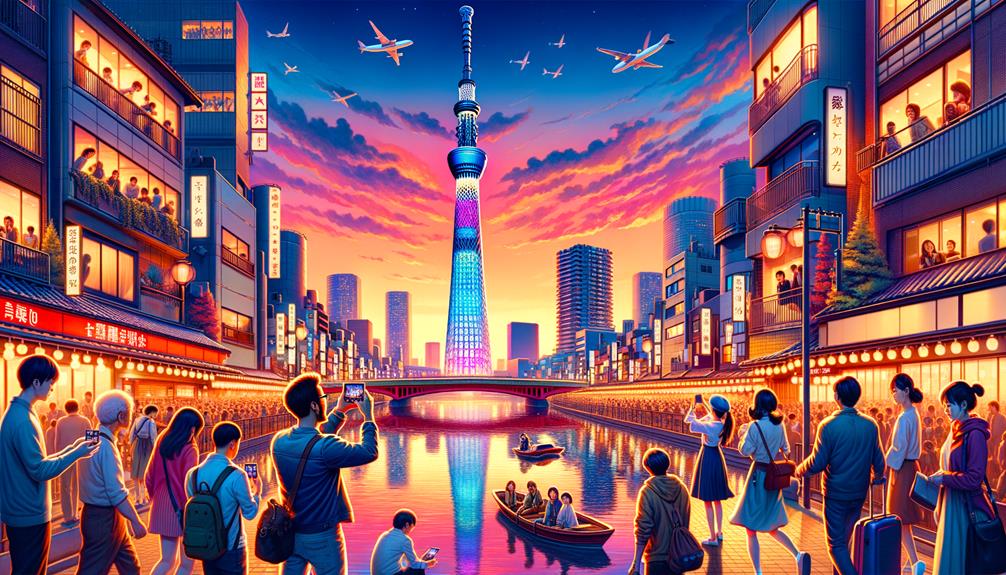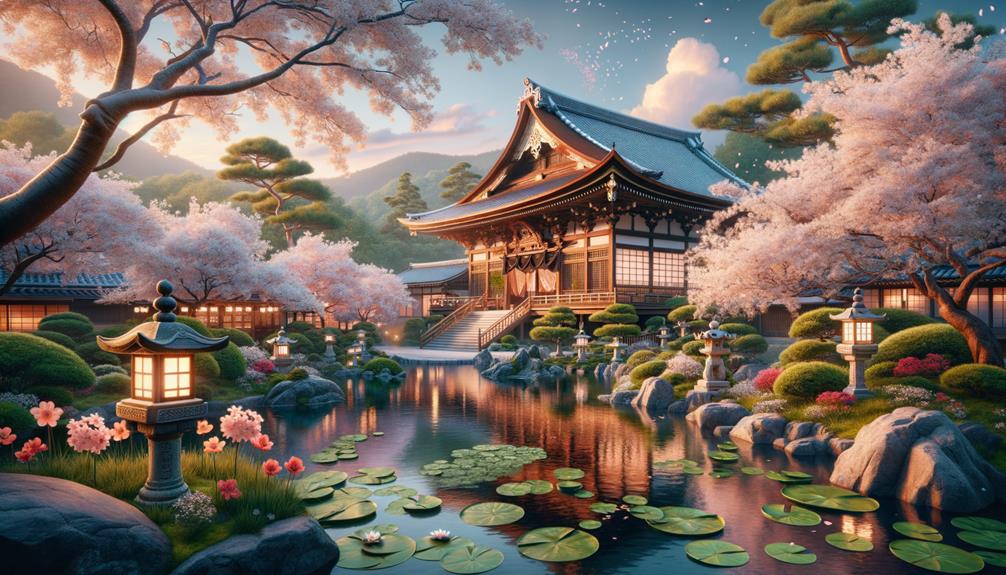It was pure luck that I ended up in Takayama during its famous festival, an event that truly showcases Japan's rich cultural heritage. The lantern-lit yatai floats, each a stunning example of traditional craftsmanship, moved gracefully through the streets, lighting up the historic buildings. As the Goshinko procession went by, participants in elaborate traditional costumes moved with an elegance that highlighted their devotion. When night came, the rhythmic chants and synchronized movements turned the town into a magical scene. This celebration is deeply touching and goes beyond just being a festival.
Overview of Takayama Festival
The Takayama Festival, held in both spring and fall, is a highlight of Takayama City with its stunning yatai floats and deep-rooted cultural traditions. Walking through the lively streets, I felt the history and community spirit that define the festival. Each season has its own special appeal—spring features 12 yatai floats, while fall has 11, all showcasing traditional craftsmanship.
Participants dress in kamishimo, garments similar to those worn by Edo Period samurai, adding an authentic historical touch to the colorful parades. The festival attracts around 200,000 visitors every year, a testament to its lasting charm and cultural importance. It's one of Japan's top three hikiyama festivals, and the sense of heritage is evident in every aspect.
The floats, both detailed and majestic, highlight local artistic talent. They're more than just decorations; they symbolize the community's hard work and pride. As I mingled with the crowd, I realized that the Takayama Festival doesn't just preserve traditions—it brings them to life. It's a celebration where the past and present blend seamlessly, creating a truly memorable experience.
Spectacular Yatai Floats

Strolling through the Takayama Festival, I'm in awe of the yatai floats. Each one is a stunning work of art, with detailed wood carvings and golden accents. As evening sets in, hundreds of chochin lanterns light up the floats, giving the streets a magical glow. The skill and cultural meaning behind these displays make the festival truly memorable.
Intricate Float Decorations
At the heart of the Takayama Festival, yatai floats showcase stunning craftsmanship with their intricate wood carvings and detailed metalwork. These floats, a tribute to the artisans' dedication, are adorned with ornate designs that capture attention and evoke emotion. As I wandered through the streets, I couldn't help but be amazed by the detailed artistry on every inch of these structures. Dating back to the 17th century, these floats are more than just vehicles; they are moving works of art, each one narrating a unique story through its elaborate decorations.
One of the most captivating elements of these floats is the karakuri ningyo, or mechanical dolls, which perform traditional dances. Operated by skilled puppeteers, these dolls bring history to life with their precise and artistic movements. The embroidery draping each float adds texture and color, enhancing their already breathtaking appearance. Clearly, these yatai floats are more than just festival attractions; they symbolize Takayama's rich cultural heritage and the enduring spirit of its people. Observing them, I felt a deep connection to the past, a reminder of the timeless beauty of human creativity.
Nighttime Lantern Displays
As the sun goes down, the yatai floats light up with about 100 lanterns each, turning the streets of Takayama into a mesmerizing scene. The atmosphere during the Yoimatsuri evening festival is absolutely enchanting. Walking through the lantern-lit paths, I felt like I had entered another world where tradition and art come to life in the most vibrant way.
The detailed decorations and colorful designs of the yatai floats look stunning under the lanterns' glow. Every detail, from the intricate carvings to the bright fabrics, seemed to dance in the soft, warm light. Performers and parade marshals in traditional costumes move gracefully alongside the floats, adding to the magical feel.
The Goshinko procession, held during the autumn festival on October 9 and 10, is especially breathtaking. Lanterns light up the traditional costumes, making the whole scene shine with timeless beauty. Watching the lantern-lit yatai floats and the procession, I couldn't help but think about the rich cultural heritage being celebrated. It's a beautiful mix of the past and present, all coming together in a spectacular display.
Traditional Costumes and Nighttime Beauty
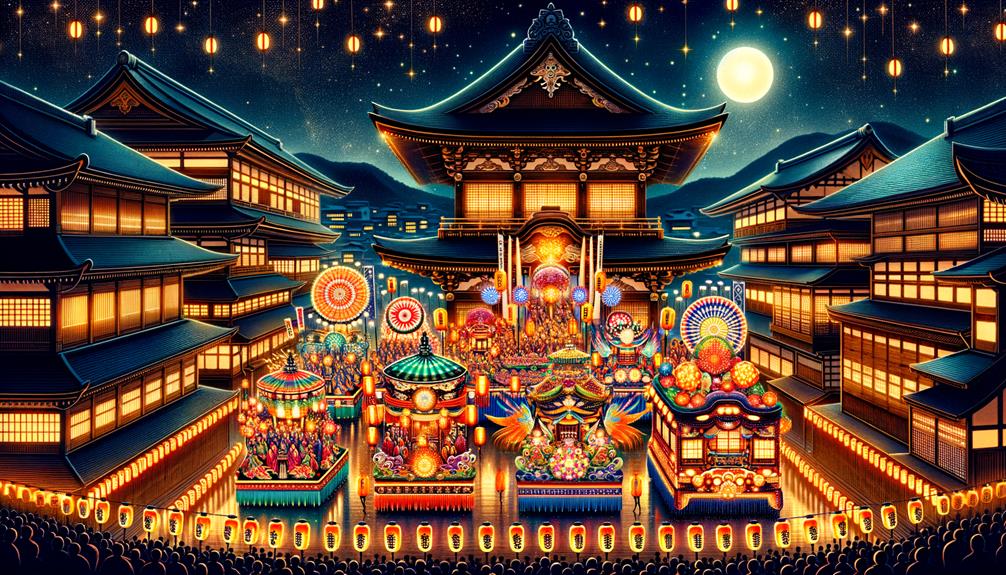
Watching the Goshinko procession was a sight to behold. The traditional costumes were so detailed that I couldn't take my eyes off them. But what really added a touch of enchantment was the Yoimatsuri at night. With around 100 lanterns lighting up 11 yatai floats, the festival seemed to glow with magic. The vivid costumes against the gentle lantern light made the whole scene feel almost dreamlike.
Stunning Traditional Costumes Procession
I had the chance to witness the Goshinko procession at the autumn Takayama Festival, and I was blown away by the intricate traditional costumes worn by the participants. These outfits, handed down through generations, were vibrant and adorned with detailed embroidery, reflecting a rich heritage. Alongside the participants, majestic yatai floats paraded through the streets, each a testament to exceptional craftsmanship.
The traditional parade was a sensory delight, offering a rare look into Japan's cultural tapestry. The costumes, with their elaborate patterns and harmonious colors, stood out brilliantly against the night sky. Each participant seemed like a living, breathing piece of art.
| Element | Description |
|---|---|
| Costumes | Intricate, generational, vibrant embroidery |
| Yatai Floats | Majestic, handcrafted, cultural symbols |
| Procession | Traditional, immersive, historical |
| Atmosphere | Nighttime, magical, mesmerizing |
| Participants | Proud, dedicated, culturally rich |
Reflecting on the event, I felt a deep respect for the participants' dedication and pride. The way the traditional costumes and yatai floats came together under the evening sky was both magical and deeply moving. It felt like stepping back in time, where tradition and beauty merged in a harmonious celebration.
Lantern-Lit Yatai Floats
Seeing the lantern-lit yatai floats set against the historic backdrop of Takayama is something truly special. As night falls, about 100 lanterns light up 11 stunning yatai floats, creating a warm and magical glow that turns the streets into something out of an old story. The atmosphere at night gets even better with the traditional costumes worn by those in the Goshinko procession. These detailed and colorful outfits bring an extra layer of beauty to the event.
Reflecting on the evening, three main things stood out to me:
- Illuminated Yatai Floats: The 11 floats, each decked out with many lanterns, offer a captivating display that really brings out the festival's historical charm.
- Traditional Costumes: Participants wear elaborate outfits showcasing Japan's cultural heritage, from embroidered kimonos to ceremonial headgear, adding to the overall beauty of the event.
- Nighttime Atmosphere: The soft glow of lanterns against the night sky, mixed with the sounds of Tokeiraku performers, creates an unforgettable ambiance.
The Yoimatsuri evening festival captures the spirit of Takayama perfectly, blending tradition and beauty under a serene night sky, offering a timeless sense of wonder.
Performances and Processions
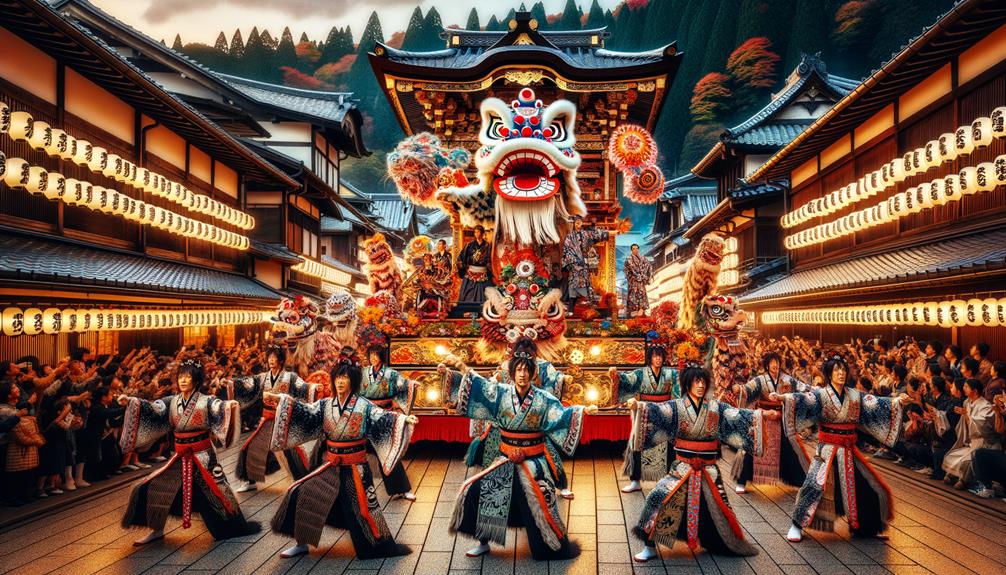
Every year, the Takayama Festival draws people in with its amazing performances by karakuri ningyo on intricately decorated floats. Watching these mechanical dolls move with such grace and precision is truly magical. Skilled puppeteers bring these marionettes to life, showcasing traditional dances and complex displays that highlight centuries of cultural heritage. The craftsmanship involved in these float performances is a testament to Takayama's enduring artistry.
As I strolled through the festival, the mikoshi procession caught my eye. This portable shrine, carried with great respect through the busy streets, was impressive. The participants, dressed in beautiful traditional costumes, worked together in a way that added a strong sense of unity and devotion to the event. Their rhythmic chants and synchronized movements created an atmosphere that transported me back to a time-honored celebration of community and faith.
When night fell, the festival turned into a glowing wonderland. Lantern-lit parades brightened the ornate yatai floats, casting a soft light over the historic streets. The Goshinko procession, with its stunning traditional costumes and cultural displays, was a breathtaking highlight, capturing the essence of Japan's rich cultural heritage.
Attractions in Historic Takayama
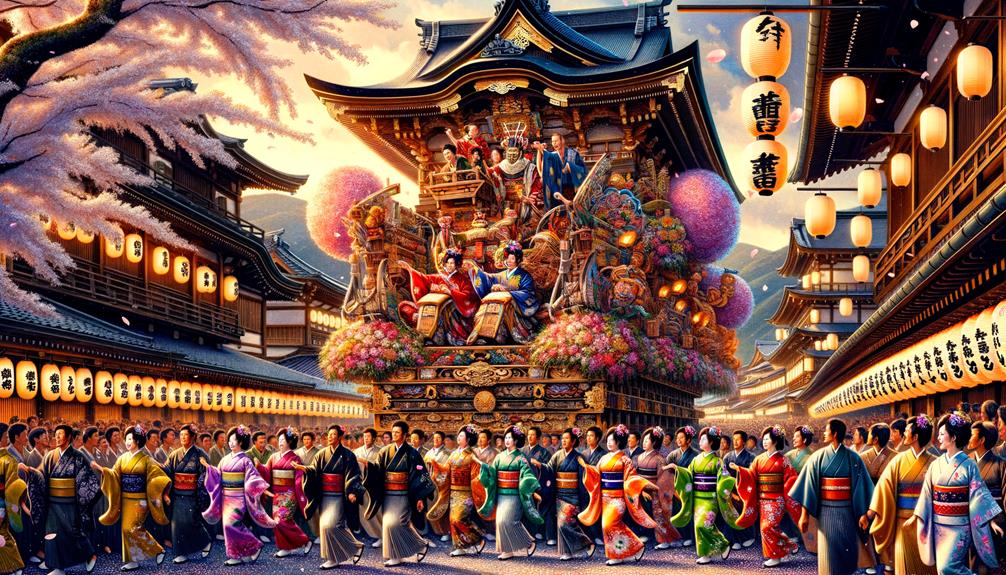
Takayama's old town is like a window into the past, with its Edo-period architecture and lively cultural spots that bring history to life. Walking around the historic district feels like time travel. The narrow streets lined with traditional wooden houses give off a nostalgic vibe that's hard to resist.
One standout moment for me was visiting the Takayama Matsuri Yatai Kaikan. The yatai floats on display are incredibly detailed and beautiful, even when the festival isn't happening. Watching locals carefully attach decorations to these floats added another layer to the experience.
If you're in Takayama's historic district, don't miss these three attractions:
- Takayama Jinya: This old government office offers insight into the administrative life of the Edo period.
- Jinyamae Asaichi Morning Market: This bustling market is full of local produce and crafts, capturing the heart of Takayama's community.
- Takayama Matsuri Yatai Kaikan: Home to the stunning yatai floats, it's a key part of the area's cultural heritage.
Visiting these spots made me feel deeply connected to Takayama's rich history and enduring traditions.
Planning Your Visit
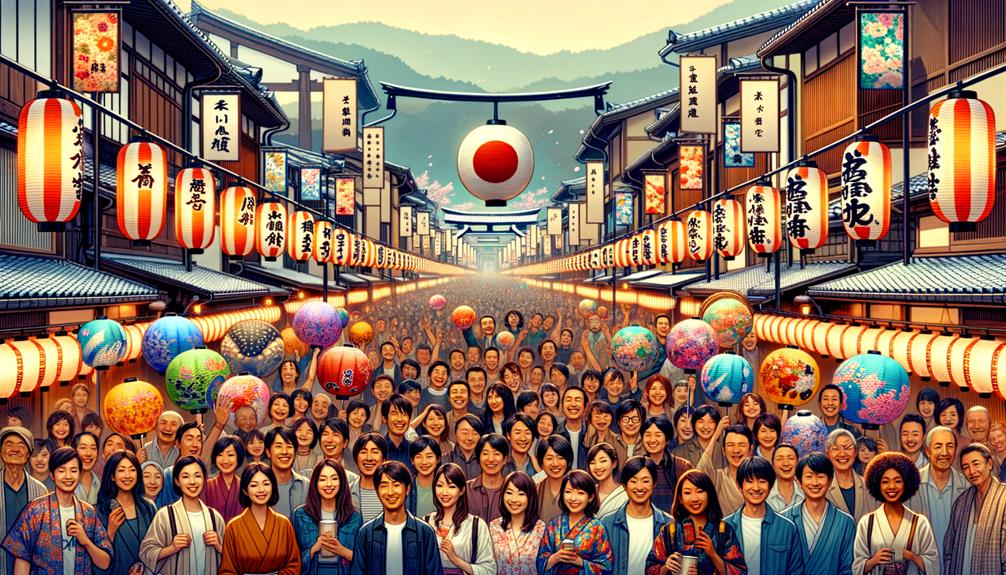
Planning a visit to the Takayama Festival takes some preparation, but the experience is well worth it. Start your journey at Takayama Station, the main hub for accessing the festival's highlights. From there, you'll find the captivating float parades and the historic Hie Shrine just a short distance away.
Given the festival's popularity, booking your accommodations early is a must. With around 200,000 visitors each year, hotels and other lodging options can fill up quickly. Staying near Takayama Station is convenient and allows you to immerse yourself in the local culture.
Here's a helpful table to guide your planning:
| Aspect | Details |
|---|---|
| Transportation | Arrive via Takayama Station |
| Main Venues | Hie Shrine, Sakurayama Hachimangu |
| Key Events | Floats parade, karakuri puppet displays, illuminated floats |
| Accommodation | Reserve early near Takayama Station |
The festival offers a sensory delight with its grand parade of intricately decorated floats and participants dressed in traditional attire from Japan's Edo Period. The nighttime float illuminations add a magical touch, making the Takayama Festival an event not to be missed. By planning ahead, you can ensure a smooth and enriching experience.
Frequently Asked Questions
What Happens at Takayama Festival?
You might think it's just another festival, but Takayama Festival stands out because of its rich history. I was amazed by the detailed yatai floats, the traditional Edo-period clothing, and the captivating karakuri puppet shows.
Is the Takayama Festival Worth It?
Absolutely, the Takayama Festival is worth attending. I was awestruck by the intricate floats, traditional attire, and lively performances. The festive energy and deep cultural roots truly impressed me. It's a memorable way to experience Japanese heritage up close.
What Are the Three Most Beautiful Festivals in Japan?
I think the three most beautiful festivals in Japan are Hanami, Gion Matsuri, and the Takayama Festival. Hanami is all about enjoying the cherry blossoms, Gion Matsuri lights up with lanterns, and the Takayama Festival showcases the vibrant colors of autumn. Each one offers a unique glimpse into Japanese culture that's truly special.
What Is Special About Takayama?
Takayama's magic lies in its mix of historic streets and lively cultural festivals. Wandering through the town, I was fascinated by the detailed yatai floats and the vibrant traditions that bring this place to life.


